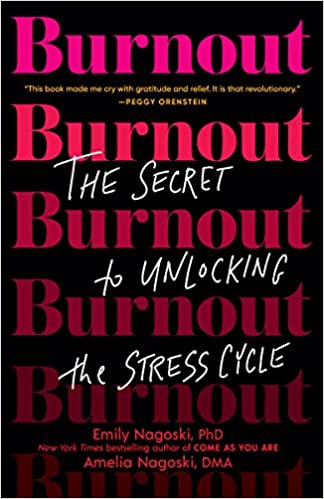Burnout: The Secret to Unlocking the Stress Cycle by Emily Nagoski, Amelia Nagoski
Ever feel so burnt out you resemble a slice of overdone toast? If you’re a giver by need or nature, which encompasses most people who identify as female, as well as a number of men, stress is your companion. You may have tried any number of ways to deal with it—yoga, meditation, mindfulness, the newest Beyoncé album—but whatever you do stress seems always to gain the upper hand. The reason why it’s so hard to defeat is simple and surprising, according to Emily Nagoski Ph.D. and Amelia Nagoski, DMA, whose new book, Burnout: The Secret to Unlocking the Stress Cycle (Ballantine Books) outlines a radical idea: The way to combat stress is by accepting it and completing the stress cycle.
Emily Nagoski, a therapist and sex educator, and Amelia Nagoski, a conductor and a professor of music, join forces to explore the science and social conditioning that makes stress so ubiquitous to those of us of the female persuasion. They point out that our society is generally divided between human givers and human beings, the former have been taught that their primary purpose is to sacrifice all to support the latter. (Or, as they say—patriarchy, ugh.)
This means stress is baked into our culture. So, how do we avoid it? Actually, you can’t. Stress has a role in our safety and well-being, preparing us to deal with threats. Instead, what you can do is complete the stress cycle so anxiety doesn’t build up in your body and harm you.
Stress isn’t an emotion, it’s a cycle like any other physiological cycle such as hunger or thirst. How do you stop being hungry or thirsty? Of course, completing the stress cycle requires more than a bottle of water or a power bar. Nor is it practical to follow nature’s original imperative: flight or fight—not much would be accomplished by mud wrestling in the boardroom. So what can you do?
First, realize that you can’t deal with the stressor (the thing causing the stress) until you’ve dealt with the stress itself; the cycle has to be completed. You may have already guessed that one of the best ways to do this through physical activity. A brisk walk or dancing to your favorite artist while you make lunch would work, but for those of us who are chained to our desks, the Nagoskis suggest this: Stand behind your chair and take a deep breath, tense all your muscles for 20 seconds, exhale, then shake it all out.
But the need for a physical response is only part of the stress cycle. The cycle ends when you return to a state that signals the danger is over and you feel safe. There are a variety of methods to get you back to that state. Not every technique works for every person and or every situation. You need to find what works for you—which may take some experimentation on your part.
Breathe Deeply: As basic as it sounds, deep, slow breathing can help regulate the stress response.
Find Your People: Interacting with kind people increases your body’s sense of safety. Venting with friendly coworkers helps with this. Or, phone a friend.
Have a Laugh: Laughter is still the best medicine. If you can’t find something to tickle you on Netflix, try a comedy club. Laughing with others is extra effective.
Hug it Out: A 20-second hug with someone who makes you feel safe can do a lot to complete the stress cycle. It’s important that each person supports their own weight so there is no scary disequilibrium. If you’re lucky enough to be in a healthy relationship, a six-second kiss can also accomplish this. Six seconds is just long enough to bring you back to why you like and trust this person.
Have a Good Cry: There’s a lot of sexism in the notion that crying is a weakness. A good, cleansing cry can help you cycle through strong emotions. Just ask any fan of “This is Us.”
Get Creative: Some of the best poems and songs have been written as a way to work through the stress cycle. (Where would country music and teen ballads be without it?) Everything from playing the trombone to knitting a sweater helps. Finishing a project or artistic performance helps even more. And here’s another great thing to know—indulging in a television show, book or movie where things are resolved in a positive way is great for helping complete the cycle. Why do you think so many people love police procedural shows?
The important thing is to realize that well-being isn’t a goal, but rather a fluid state that is always in action. By taking care of yourself day-to-day and giving your body what it needs, you keep stress from becoming toxic.
There’s much more to Burnout than techniques. The Nagoskis discuss the stress-response cycle, the brain mechanism that controls emotion and how finding meaning in life can help us deal with our stress. They reveal the real enemy when it comes to stress and share the best and most recent science on this problem. Burnout feels revelatory and, in a world where most books on the subject overlook the price women, especially women of color, pay for stress, it feels absolutely essential. You’ll never approach stress the same way again.
Burnout: The Secret to Unlocking the Stress Cycle is now available for purchase.
Buy this Book!
Amazon





